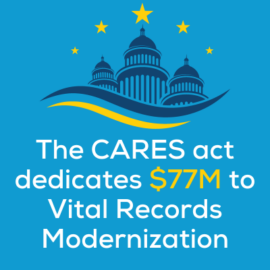3 Keys to Successfully Modernizing Vital Records Management Systems
3 Keys to Successfully Modernizing Vital Records Management Systems
 It’s no secret that data can improve public health outcomes, but only if the right tools are in place to collect, share, and analyze it. The Coronavirus Aid, Relief, and Economic Security (CARES) Act allocated $200 million to public health data modernization efforts for that very reason, including $77 million for vital records modernization programs.
It’s no secret that data can improve public health outcomes, but only if the right tools are in place to collect, share, and analyze it. The Coronavirus Aid, Relief, and Economic Security (CARES) Act allocated $200 million to public health data modernization efforts for that very reason, including $77 million for vital records modernization programs.
Modernization is an urgent matter, as almost two-thirds of states have vital records management systems (VRMS) that are more than 10 years old. At the same time, three-quarters of state IT spending is used to maintain such legacy systems. No wonder state CIOs listed modernization as one of their top five post-COVID priorities.
When done right, modernization can breed cost savings, greater efficiency, and improved health outcomes. The question, for states, is what to focus on as they begin their modernization journeys. Let’s look at three keys to successfully modernizing vital health records specifically.
Improving timeliness
One of the greatest benefits of modernization is the degree to which it can reduce the processing time of vital records from years to months—and sometimes to mere days. Many vital records organizations struggle with a backlog of birth and death certificates because of delays in certification. One way to improve timeliness is to make the certification of vital records easier through mobile apps like New York City’s eVital, which allow for certification to happen anytime, anywhere.
Interoperability
Interoperability speaks to the ease at which different systems pass information to each other. VRMS must interact with numerous parallel systems, including surveillance systems that monitor drug overdose deaths, the national cancer registry, the National Vital Statistics System – and that’s just to name a few. Naturally, it’s crucial to make sure those systems can work together seamlessly, the result of which can help streamline services and inform potentially life-saving insights by generating nearer to real-time data on opioids, suicide, cancer, and all causes of death.
The Fast Healthcare Interoperability Resources’ (FHIR) standard underpins interoperability by enabling health IT systems to communicate using a common language. Already, Voyatek is working with New York’s Bureau of Vital Statistics (BVS), one of the nation’s largest-volume vital records jurisdictions. Its efforts, funded by the CARES Act, will establish uniform system standards and functionality to promote cross-unit interoperability. This should be a priority for any government agency seeking to modernize its VRMS.
Stability and security
While modernization has many benefits, its progress can quickly be undone by a security breach. When the city of Joplin, Missouri was hit by a ransomware attack, bad actors sought access to its birth and death records. More recently, a cyberattack against a digital-records management vendor forced local governments to revert to manual, paper-based processes for everything from birth certificates to marriage licenses. Thus, as states begin modernization, security must be considered from day one.
Some vital statistics solutions use facial recognition technology to ensure security. Additionally, decentralized identity solutions allow governments to issue digital birth and death certificates as verifiable credentials, which are stored securely in the resident’s digital wallet. This provides a more secure method of authentication because the credentials are digitally signed and encrypted, making them difficult to forge or tamper with. With decentralized identity, agencies no longer store vast amounts of personally identifiable information, leaving little incentive for cyber attackers to hack into their systems.
The goal of modernization is to make VRMS seamless, secure, and scalable. Additionally, governments could save an estimated $110 billion by eliminating the need to maintain outdated legacy systems. And yet, despite CARES Act funding, modernization remains a daunting prospect for many agencies. The good news is that Voyatek is here to help. If you’re ready to modernize your vital health records but aren’t sure where to begin, get in touch today.
-Voyatek Leadership Team

